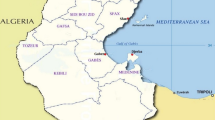Abstract
The Oomycete Plasmopara viticola is the causal organism of downy mildew on grapevine (Vitis spp.). In order to set up the techniques for investigating downy mildew disease dynamics and genetic structure, co-dominant, neutral, highly reproducible and polymorphic microsatellite markers for P. viticola were developed. Five markers, two with a (TC)n repeat (loci BER and ISA), two with a (TC)n(AC)n repeat (loci CES and REX) and one with a (CT)n(CTAT)n repeat (locus GOB), were selected. Simple sequence repeat (SSR) markers revealed different degrees of polymorphism within 190 oil spots (disease symptoms) collected from an infected Italian vineyard. The most polymorphic SSR marker GOB showed 43 alleles (Nei's expected gene diversity He = 0.89) while CES, ISA, BER and REX showed 14 (He = 0.71), 4 (He = 0.57), 3 (He = 0.24) and 1 allele (He = 0), respectively. A high throughput DNA extraction method, that allowed molecular analysis of this obligate pathogen directly in the host without any isolation procedure, was developed. The quality and quantity of oil spots did not influence the SSR analysis. Amplified SSR loci were separated by electrophoresis on a Beckman–Coulter 2000XL sequencer and automatically analysed. The objective of this study was to develop molecular biological tools and methods that allow high throughput analysis of the downy mildew populations.
Similar content being viewed by others
References
Aldrich J and Cullis CA (1993) CTABDNAextraction from plant tissues. Plant Molecular Biology Reporter 11: 128-141
Ashley MW and Dow BD (1994) The use of microsatellite analysis in population biology: Background, methods and applications. In: Schierwater B, Streit B, Wagner GP and DeSalle R (eds) Molecular Ecology and Evolution: Approaches and Applications (pp 185-201) Birkhäuser, Basel, Switzerland
Blaeser M and Weltzien HC (1979) Epidemiologische Studien an Plasmopara viticola zur Verbesserung der Spritzterminbestimmung. Zeitschrift fur Pflanzenkrankheiten und Pflanzenschutz 86: 489-498
Brown M, Moore JN, Fenn P and McNew RW(1999) Comparison of leaf disk, greenhouse, and field screening procedures for evaluation of grape seedlings for downy mildew resistance. HortScience 34: 331-333
Bruford MW and Wayne RK (1993) Microsatellite and their applications to population genetic studies. Current Opinion in Genetics & Development 3: 939-943
Burruano S, Conigliaro G and Di Graziano M(1990) Prime indicazioni sull'azione delle basse temperature sulla germinazione delle oospore di Plasmopara viticola. Phytopathologia Mediterranea 29: 73-75
Callen DF, Thompson AD, Shen Y, Philips HA, Richards RI, Mulley JC and Sutherland GR (1993) Incidence and origin of 'null' alleles in the (AC)n microsatellite markers. The American Journal of Human Genetics 52: 922-927
Goudet J (2001) FSTAT, a program to estimate and test gene diversities and fixation indices (version 2.9.3). Journal of Heredity 86: 485-486
Groppe K, Sanders I, Wiemken A and Boller T (1995) A microsatellite marker for studying the ecology and diversity of fungal endophytes (Epichlöe spp.) in grasses. Applied and Environmental Microbiology 61: 3943-3949
Gupta PK, Balyan HS, Sharma PC and Ramesch B (1996) Microsatellites in plants: a new class of molecular markers. Current Science 70: 45-54
Hill GK (1990) Plasmopara Risk Oppenheim-a deterministic computer model for the viticultural extension service. Notiziario sulle Malattie delle Piante 111: 231-238
Lafon R and Clerjeau M (1988) Downy mildew. In: Pearson RC and Goheen AC (eds) Compendium of Grape Diseases (pp 11-13) APS Press, St. Paul, Minnesota, USA
Lalancette N, Ellis MA and Madden LV (1988a) Development of an infection efficiency model of Plasmopara viticola on American grape based on temperature and duration of leaf wetness. Phytopathology 78: 794-800
Lalancette N, Ellis MA and Madden LV (1988b) A quantitative model for describing the sporulation of Plasmopara viticola on grape leaves. Phytopathology 78: 1316-1321
Laviola C, Burruano S and Strazzeri S (1986) Influenza della temperatura sulla germinazione delle oospore di Plasmopara viticola (Berk. et Curt.) Berl. et De Toni. Phytopathologia Mediterranea 25: 80-84
Nei M (1973) Analysis of gene diversity in subdivided populations. Proceedings of the National Academy of Sciences of the United States of America 70: 3321-3323
Rafalski JA, Vogel JM, Morgante M, Powell W, Andre C and Tingey V (1996) Generating and using DNA markers in plants. In: Birren B (ed) Nonmammalian Genomic Analysis: A Practical Guide (pp 75-134) Academic press, San Diego, USA
Schruft G and Kassemeyer HH (1999) Rebenperonospora. In: Thomas Mann Verlag (ed) Krankheiten und Schädlinge der Weinrebe (pp 14-17) Gelsenkirchen-Buer, Germany
Tenzer I, Degli Ivanissevich S, Morgante M and Gessler C (1999) Identification of microsatellite markers and their application to population genetics of Venturia inaequalis. Phytopathology 89: 748-753
Wagner HW and Sefc KM (1999) IDENTITY 1.0. Centre for applied genetics, University of agricultural sciences, Vienna (available at: http://www.boku.ac.at/zag/forsch/identity.htm)
Weber JL and May PE (1989) Abundant class of human DNA polymorphism which can be typed using the polymerase chain reaction. American Journal of Human Genetics 44: 388-396
Wong FP, Burr HN and Wilcox (2001) Heterothallism in Plasmopara viticola. Plant Pathology 50: 427-432
Author information
Authors and Affiliations
Corresponding author
Rights and permissions
About this article
Cite this article
Gobbin, D., Pertot, I. & Gessler, C. Identification of Microsatellite Markers for Plasmopara viticola and Establishment of High throughput Method for SSR Analysis. European Journal of Plant Pathology 109, 153–164 (2003). https://doi.org/10.1023/A:1022565405974
Issue Date:
DOI: https://doi.org/10.1023/A:1022565405974




